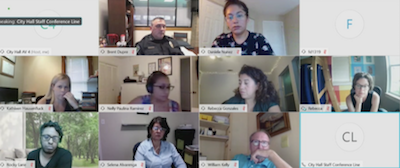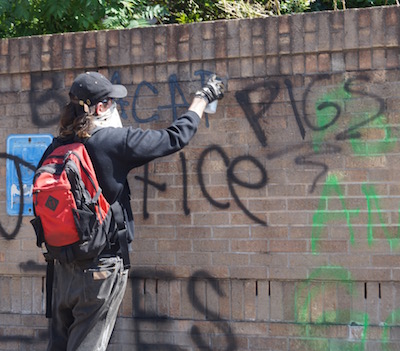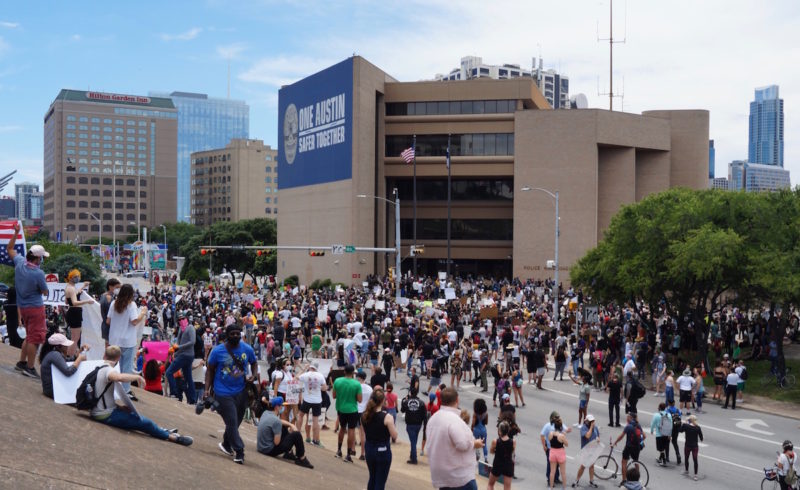Austin’s Public Safety Commission yesterday discussed a plan to demolish and redevelop the Austin Police Headquarters, a five-story downtown building, as part of the city’s policy of “reimagining public safety.”
The Public Safety Commission is an advisory body to the City Council, so it doesn’t have the power to approve a demolition plan. But its discussion Wednesday came at the behest of Jimmy Flannigan, a council member who played a leading role in a recent budget vote to slash police spending.
Introducing the agenda item, Commissioner Rebecca Webber said, “Y’all, this came out of our new way of collaborating with the Council Public Safety Committee that’s made up of four members. And it’s one of the items that the chair, Council Member Flannigan, asked this committee to start trial-ballooning and bringing to the public and the media.”
She continued, “Jimmy Flannigan’s idea is that APD headquarters would be moved somewhere else and that that land right there at 8th and I-35 would be redeveloped in a way that honors the movement that’s been going on this summer as far as valuing Black and Brown lives.”
“And that it would also be the embodiment of council’s reimagining public safety so that the public safety aspects of it would not necessarily be police but would be services and things like that.”
Flannigan had proposed the idea on July 27, writing on an official council message board, “the building that houses APD HQ and formerly housed the Municipal Court has long been known to be beyond the end of it’s useful life. We should expedite the demolition of the APD Headquarters by directing the City Manager to move all remaining APD staff out of the existing headquarters building and into other underutilized city facilities.”

“That property – which has significant value given its downtown location… should be dedicated to addressing historic economic inequities in the black community and supporting future black community economic success. A community-led effort should be initiated to determine the specifics on how such a valuable property could be leveraged, and possibly serve as a gateway to East Austin.”
Four invited speakers from the public addressed yesterday’s meeting, as well as a member of the city’s finance office.
The first public speaker was Conor Kenny, a former chair of the Public Planning Commission who was appointed to that role by Council Member Greg Casar, and who now works for a private developer, Civilitude.
Kenny struck a different tone from Webber, trying to steer the conversation away from de-policing per se to questions of whether the current APD building was the best use of city property: “I really do not see this as part of the ‘defund the police’ conversation. APD has had complaints about this site for a long time, it’s destined to be redeveloped with at least a substantial portion of the department moving offsite.”
“So it’s really just a question of how to best use this site, and I think that’s really what our council committee is asking for.”
He introduced the idea that the site could still house some public safety functions on its lower floors while upper floors would be used for residential or office development. Some space could also be slated for use by nonprofits, he said, before introducing three other invited speakers, two of whom work for local nonprofits.
Kenny noted the building is under a zoning restriction that constrains its height because it within a “capital view corridor,” adding, “But if the council wanted to look at easing that, because of the value of the site you could potentially look at a private office or residential development that could really subsidize quite a bit of space through a public-private partnership.”
Money isn’t an obstacle for the council, he said. “I also don’t think that funding here is necessarily an impediment depending on how far council wants to take this.”

The next to speak was Selena Xie. President of the Austin EMS Association, who said that one possible use for the building was a “joint public safety use facility so that during times of really high use of 6th Street on the weekend nights that all the agencies can get together and debrief of about whether there are any credible threats, what type of crowds we are expecting, what the game plan is.”
However, Xie cautioned against selling the property outright, saying, “I do really think that it should continue to stay in the city’s hands.” She noted that downtown Austin is a busy area for EMS and because of high downtown real estate prices “we don’t have the luxury to just purchase buildings.”
She also noted, “APD won’t have another place to house all their officers downtown, their bikes (etc), and that will make it really challenging for us to provide a good service downtown. I don’t know what kind of timeline we’re looking at now but APD obviously has over 400 folks working in there now.”
The Austin EMS Association has endorsed Jimmy Flannigan, with President Selena Xie calling him a “leader on improving public safety.”
The next to speak was Shoshana Krieger with BASTA, a group that helps tenants to form tenants’ associations at rental properties. She asked, “What could the world look like if we really expanded our conception of public safety and would be able to have a place which housed and supported so many crucial nonprofit resources which exist in Austin?”
“APD obviously has over 400 folks working in there now.”
Krieger conceded that BASTA’s work “traditionally wouldn’t be defined as public safety,” but added, “a lot of it does impact public safety. What we’re dealing with every day is a power imbalance between landlords and tenants, which leaves tenants in very precarious positions…”
The final speaker was Preston James, CEO of DivInc, a company that aims to “bridge the gap between underrepresented entrepreneurs and the resources they need to build profitable, high-growth companies.”
Introducing him, Conor Kenny said, “I’m really excited about the work that they’ve been doing over at DivInc and with this site (APD HQ) being almost a literal bridge between the East Side and the wealth and income generation downtown, and what we could do more metaphorically to bridge that divide.”
James said, “I’m really interested in maximizing the opportunity for our communities to do a couple of things. From an entrepreneurship perspective, how do we create more opportunities for the Black community, Brown community to explore… to build skill-sets and get access to mentorship and the resources that they need?”
He didn’t specifically address questions of policing or shared uses of the building, keeping his comments general. “There is a lack of access to the essential resources needed for entrepreneurship,” James said. “I look at this as an opportunity to really raise the level of access to critical resources.”
Cost Unknown
City staff and leaders haven’t yet contemplated the cost of a plan to relocate Austin Police to other city buildings. The department will be smaller after a budget cut this year, but it will still have substantial space needs.
Commission Chair Rebecca Gonzales posed a question about that to Darrel Alexander, a representative of the city’s finance office. He replied, “The first phase is we have to find some place for APD to move to. So that first phase is assessing and analyzing what’s the space needs and the requirements for that.”
“We’ve had an initial meeting but there are a couple more steps that need to happen.” Alexander noted it could take another few weeks to get going with the assessment.
The conversation ended with Commissioner Rebecca Webber asking Conor Kenny, the planning expert, about what the redeveloped site could look like. For example, “Could it be half spots for our public safety agencies and nonprofits and then half expensive what-have-you above?”
Kenny replied that the city has a lot of latitude to develop public property. “You really have a lot of potential to really build out the site really to the borders of the sidewalk. You could do a lot with the square footage per floor. Even under the Capitol view corridor you could get maybe eight to ten floors.”
He also suggested the city could modify the Capitol view restriction. “Maybe the value to the city of having some services there might exceed the value of that entire view,” he said.
“That’s a conversation the council could have. You could really stack an incredible amount of value on top of that with offices or residences which could subsidize, through a public and private partnership, a lot of space for public and social service needs – a number of floors.”
Gonzales noted, “This is a starting conversation, the city is managing this from a real estate perspective as well.”
Pushback
Politically, city leaders who led the charge on cutting police services are under attack. Several incumbents who voted for the police cuts faces challengers on the November ballot who are taking aim at them for their public safety record.
Flannigan himself faces two challengers critical of him on public safety, including, Mackenzie Kelly, a former emergency response worker.

Kelly yesterday took the “Back the Blue” pledge that Governor Greg Abbott has called on candidates to take. The written pledge shows her support for “the brave law enforcement officers who risk their lives to protect and serve,” adding, “Defunding our police departments would invite crime into our communities and put people in danger.”
Dr. Jen Mushtaler, an Ob/Gyn running against Flannigan, says on her website, “I do not support defunding or shaming law enforcement. It is reasonable to advocate for both a city that is safe and for law enforcement that performs without prejudice and unnecessary force. The two are not mutually exclusive.”
“I believe we can, and should, have fully accountable citizen protection, but I do not believe we should eliminate or dramatically reduce law enforcement.”
Law enforcement groups also are getting involved in the effort to unseat incumbents and pressure the council. Yesterday two billboards appeared on the north and south ends of I-35 leading into the City of Austin warning, “Austin Police Defunded, Enter At Your Own Risk!”
The billboards were placed by the Texas Municipal Police Association. The group’s Executive Director Keven Lawrence commented, “The safety of Austin citizens and visitors has never been more at risk from dangerous policies propagated by their own locally elected officials”

The Police Association has called the APD budget cut a “political stunt by the city council pandering to the radical left.”
Austin City Council acted to slash the city’s police budget after months of protest calling for defunding the police. The first major protest in Austin took place in front of the Austin Police Headquarters.
Though the protests were sparked by anger over incidents of police shootings, and the death of George Floyd, an unarmed Black man, some protesters not only called for an end to incidents of unnecessary force and brutality but also more radical measure like defunding the police outright. Some sought to incite violence against police officers; the APD Headquarters was spray-painted with large graffiti saying “Kill Cops,” “ACAB” (All Cops Are Bastards), “Pigs,” and “Dead Cops Save Lives.”
